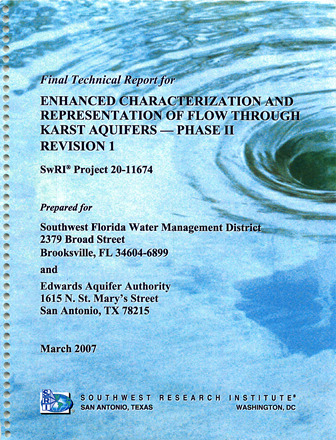Enhanced Characterization and Representation of Flow through Karst Aquifers-Phase II Revision 1

| Author | Painter A, Sun A and Green RT |
| Year | 2007 |
| Description | Development and testing of the MODFLOW DCM version 2.0 model for karst aquifers |
| Report Number | SwRI Project 20-11674 |
| Publisher | Southwest Research Institute |
| Location | Edwards Aquifer, Balcones Fault Zone, Barton Springs Segment; Floridan Aquifer, Santa Fe River Sink/Rise system |
| Cover | View Download |
| File | View Download |
| Summary |
|
In 2003, Southwest Research Institute® (SwRI) initiated a long-term project to develop new modeling approaches and tools to address applications involving karst aquifers with significant conduit flow. Phase I of the project identified key considerations for modeling karst aquifers, evaluated existing modeling approaches, and selected an approach for detailed investigation and development. To meet the modeling needs, DCM Version 1.0, a dual-conductivity model for MODFLOW, was developed. The first application using DCM enhanced an existing MODFLOW model for the Barton Springs segment of the Edwards Aquifer. Reasonable replication of the conduit/matrix flow system was achieved in terms of matching hydraulic heads and spring discharge. Phase II of the karst modeling project was commissioned by the Edwards Aquifer Authority and the Southwest Florida Water Management District and initiated in mid-2005. The objective of Phase II was to enhance the karst modeling approach that was developed during Phase I and assess the capability and limitations of DCM by applying it to two karst aquifers that exhibit contrasting hydrogeologic characteristics: the Barton Springs segment of the Edwards Aquifer in south-central Texas and the Santa Fe River Sink/Rise system of the Floridan Aquifer in north-central Florida. … A new solver capable of solving the highly nonlinear systems associated with the conduit/matrix flow regime under confined/unconfined conditions was developed. …. Because of this new data requirement, the resulting dual-conductivity model could not be implemented as a self-contained package, and it was necessary to modify multiple packages. Therefore, a new MODFLOW variant, MODFLOW-DCM Version 2.0, was created. .. The Barton Springs model was completely revised in Phase II by incorporating site-specific groundwater hydraulic data and more detailed conduit characterization information. The model was successfully calibrated to hydraulic head and spring flows for steady and transient conditions. Sensitivities to major parameters were identified. MODFLOW-DCM successfully simulated the drying and rewetting of cells in the unconfined recharge zone of the Barton Springs model. …. Sensitivity analysis indicated that the addition of the turbulence model resulted in an improved match to the dynamic spring hydrograph for Barton Springs and that the matrix/conduit exchange parameter can be tuned to allow for a better match of dynamic spring flow. Model results also highlighted the sensitivity of spring discharge to conduit elevation relative to matrix elevation. This important outcome confirms that conduit elevations influence flow during low-flow conditions because some conduits can become dewatered when water levels are sufficiently lowered. This feature enables the conduit elevations to be determined by model calibration during low-flow periods. … MODFLOW-DCM was applied to the Santa Fe River Sink/Rise system in the Floridan Aquifer to test the ability of MODFLOW-DCM to simulate large flow karst systems with relatively high matrix permeability. Although the Santa Fe River Sink/Rise system was selected because there is extensive data on site characterization, it was necessary to develop a new MODFLOW model because the scale and resolution of existing models were inappropriate to test the ability of MODFLOW-DCM to match the dynamic hydraulics of the Santa Fe River Sink/Rise system. … The Floridan Aquifer model reasonably captured the basic hydraulic dynamics of the Santa Fe River Sink/Rise system in terms of water elevations at the River Sink and River Rise, discharge at the River Rise, and hydraulic head values at four calibration wells. … The MODFLOW-DCM variant is completed and promises to provide significant improvements in modeling groundwater flow through conduits located within porous media. Interest has shifted from model development to model calibration and parameter estimation. … Development of advanced calibration and parameter estimation tools and techniques will allow for quicker and better focused karst aquifer characterization. |
Search for Documents
Advance Search
Explore EAA's Scientific Reports
- All Reports
- Overview Studies
- Modeling
- Hydrology and Hydrogeology
- History
- Groundwater Recharge, Recharge Zone
- Groundwater Movement
- Geomorphology and Caves
- Weather Modification
- Geology
- Water Use and Conservation
- Geochemistry
- Water Resources Planning and Management
- Floods and Drought
- Water Quality
- Climatology
- Surface Water / Groundwater Relationship
- Biology
- Springs, Groundwater Discharge
- Archaeology
- RZ Protection
- Aquifer Levels
- Remote Sensing
- Precipitation
